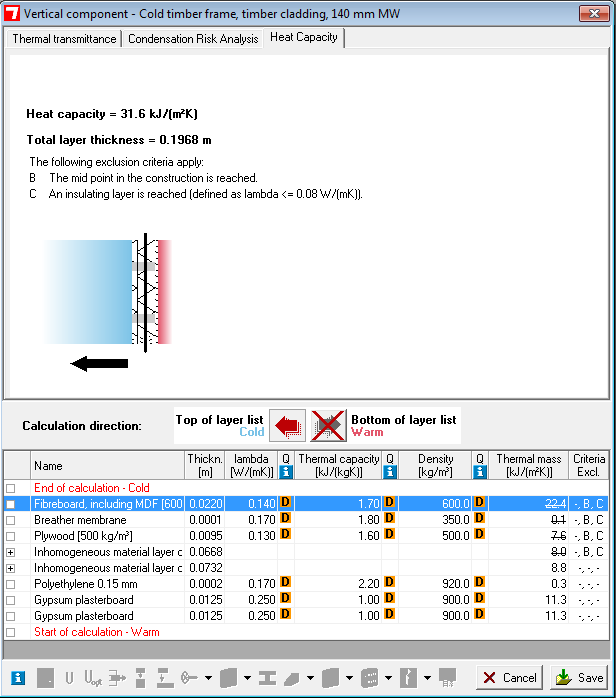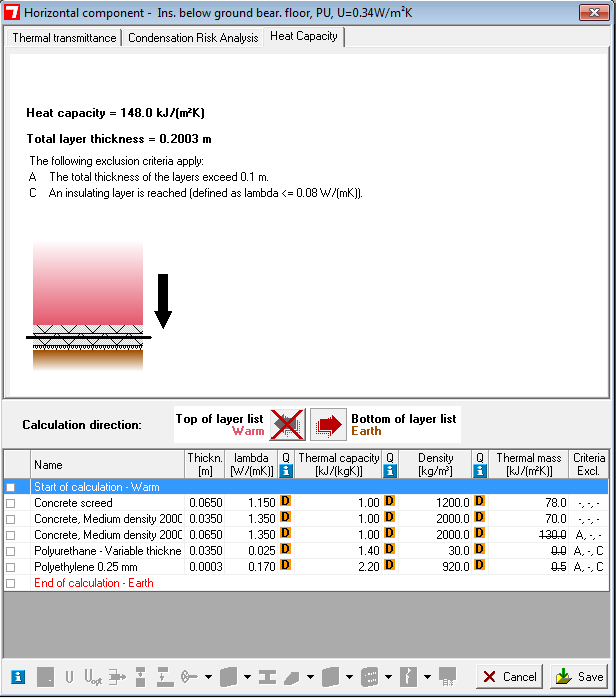Heat Capacity (Kappa value k) and Thermal Mass
The Part L Building Regulations, implemented on the 1st October 2010, require a further 25% improvement in energy efficiency. In order to deliver this, substantial improvements in fabric energy efficiency will be required.
The new SAP 2009 and existing SBEM calculations will also be heavily influenced by the thermal capacity of all the internal and external construction elements. The resultant Thermal mass of the building can then be used to reduce the heating and cooling demands of the building. This is an important aspect when designing low energy buildings. Thermal mass helps to smooth out heating and cooling loads by soaking up excess heat gains such as solar gain and releasing them when the building is cooling during the night. Passiv Haus designers make use of this principle to make the building fabric act as a thermal store and help eliminate the need for space heating. Thermal Mass can also be used to prevent overheating of buildings during summer months and reduce or eliminate the demand for cooling.
You will now need to consider the Kappa value k , the effective thermal capacity of the element, as well as it’s U-value.
An Integrated Part of BuildDesk U
To help you consider the new requirements, we have added a new Thermal capacity k calculation tab to our BuildDesk U 3.4 U-value and Condensation Risk calculation software.
As you’d expect from us, once you have modelled the build up of layers, the U-value, Condensation Risk and Heat capacity k of the construction are readily available on separate tabs. This new functionality is part of the latest release of BuildDesk U.

Screenshot from BuildDesk U 3.4 showing the new heat capacity display for one of our standard external walls.
What is the Heat Capacity (k) of a building element?
The k -value is the effective heat capacity per unit area and is a measure of the thermal response characteristics of the construction. The higher the number, the more heat will be stored for later release.
How is it calculated?
The heat capacity or kappa value per unit area, k in kJ/m²K, for a construction element can be calculated from:
k = 10-6 × Σ (dj rj cj)
where:
The calculation is over all layers in the element, starting at the inside surface and stopping at whichever of the following conditions is encountered first (which may mean part way through a layer):
- The total thickness of the layers exceeds 100mm
- The mid point of the construction is reached
- An insulation layer is reached (defined as thermal conductivity <= 0.08 W/mK);
dj is the thickness of layer (mm)
rj is density of layer (kg/m³)
cj is specific heat capacity of layer (J/kg·K)
The elements to be included are all external heat loss walls, floors and roofs (windows and doors are excluded as they have negligible capacity) and all internal party walls and floors.
In the case of internal walls and internal floors, the heat capacity is needed for each side of the element. Many internal constructions are not symmetrical and in this case you can take an average of the calculation from both sides. From the calculation rules, the position of the insulating layer is important, internal insulation or lightweight framed constructions can reduce the effective heat capacity substantially.
BuildDesk U allows you to calculate internal U-values and so the heat capacity can also be calculated. You are able to switch the ‘Calculation direction’ in BuildDesk U to check the heat capacity from both sides.

Screenshot from BuildDesk U 3.4 showing the new heat capacity display for one of our standard internal floors calculated from below.
Heat Capacity to Thermal Mass
The Thermal Mass Parameter (TMP) for a dwelling is required for the heating and cooling calculations. It is defined as the sum of (area x heat capacity) over all construction elements (Cm) divided by total floor area (TFA). It is obtained from the actual construction elements of walls, floors and roofs (including party and internal walls, floors and ceilings). BuildDesk U will calculate the U-value and the Heat capacity (k ) of the construction elements. These results will then need to be input in your SAP 2009 or SBEM calculations to establish the Thermal Mass of the whole building.
TMP = Cm ÷ TFA
For dwellings the Thermal Mass Parameter can vary significantly from 55kJ/m2K for a lightweight timber frame construction to 500kJ/m2K for a solid masonry construction.
